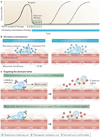Metastasis prevention by targeting the dormant niche
- PMID: 25801619
- PMCID: PMC4842412
- DOI: 10.1038/nrc3910
Metastasis prevention by targeting the dormant niche
Abstract
Despite considerable advancements that shattered previously held dogmas about the metastatic cascade, the evolution of therapies to treat metastatic disease has not kept up. In this Opinion article, I argue that, rather than waiting for metastases to emerge before initiating treatment, it would be more effective to target metastatic seeds before they sprout. Specifically, I advocate directing therapies towards the niches that harbour dormant disseminated tumour cells to sensitize them to cytotoxic agents. Treatment sensitization, achieved by disrupting reservoirs of leukaemic stem cells and latent HIV, argues that this approach, although unconventional, could succeed in improving patient survival by delaying or even preventing metastasis.
Figures



References
-
- Willis RA. The spread of tumours in the human body. London: J. & A. Chuchill; 1934.
-
- Cote RJ, et al. Monoclonal antibodies detect occult breast carcinoma metastases in the bone marrow of patients with early stage disease. Am J Surg Pathol. 1988;12:333–340. - PubMed
-
- Pantel K, et al. Frequency and prognostic significance of isolated tumour cells in bone marrow of patients with non-small-cell lung cancer without overt metastases. Lancet. 1996;347:649–653. - PubMed
-
- Husemann Y, et al. Systemic spread is an early step in breast cancer. Cancer Cell. 2008;13:58–68. - PubMed
Publication types
MeSH terms
Substances
Grants and funding
LinkOut - more resources
Full Text Sources
Other Literature Sources

